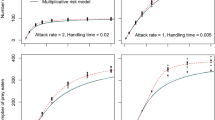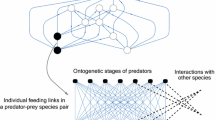Abstract
When foraging together, multiple predator species that share a single prey often cause prey mortality that cannot be predicted based on knowledge of predation by each species separately. Modeling and managing the effects of multiple predator species depend on accurately assessing these combined effects. Two methods are currently used to experimentally examine combined predation by multiple predator species: the additive and substitutive experimental designs. I simultaneously employed both experimental designs to examine predation by two crab species on shared mussel prey. I show that the two methods yield results that disagree both quantitatively and qualitatively, leading to very different conclusions about the way that predator species combine to affect prey mortality. This discrepancy occurred because the two methods examine complimentary, but not interchangeable questions. I advocate using an experimental design that incorporates both additive and substitutive designs to achieve a more complete understanding of the combined effects of multiple predator species.


Similar content being viewed by others
References
Abrams PA, Ginzburg LR (2000) The nature of predation: prey dependent, ratio dependent or neither? Trends Ecol Evol 15:337–341
Arditi R, Ginzburg LR (1989) Coupling in predator-prey dynamics: ratio dependence. J Theor Biol 139:311–326
Beddington JR (1975) Mutual interference between parasites or predators and its effect on searching efficiency. J Anim Ecol 44:331–340
Billick I, Case TJ (1994) Higher-order interactions in ecological communities: what are they and how can they be detected? Ecology 75:1529–1543
Bourdeau PE, O’Connor JN (2003) Predation by the nonindigenous Asian shore crab Hemigrapsus sanguineus on macroalgae and molluscs. Northeastern Nat 10:319–334
Brousseau DJ, Filipowicz A, Baglivo JA (2001) Laboratory investigations of the effects of predator sex and size on prey selection by the Asian crab, Hemigrapsus sanguineus. J Exp Mar Biol Ecol 262:199–210
Cardinale BJ, Harvey CT, Gross K, Ives AR (2003) Biodiversity and biocontrol: emergent impacts of a multi-enemy assemblage on pest suppression and crop yield in an agroecosystem. Ecol Lett 6:857–865
Clark ME, Wolcott TG, Wolcott DL, Hines AH (1999) Intraspecific interference among foraging blue crabs Callinectes sapidus: interactive effects of predator density and prey patch distribution. Mar Ecol Prog Ser 178:69–78
Cousens R (1991) Aspects of the design and interpretation of competition (interference) experiments. Weed Technol 5:664–673
Crumrine PW, Crowley PH (2003) Partitioning components of risk reduction in a dragonfly-fish intraguild predation system. Ecology 84:1588–1597
DeWitt TJ, Langerhans RB (2003) Multiple prey traits, multiple predators: keys to understanding complex community dynamics. J Sea Res 49:143–155
Eklöv P (2000) Chemical cues from multiple predator–prey interactions induce changes in behavior and growth of anuran larvae. Oecologia 123:192–199
Eklöv P, VanKooten T (2001) Facilitation among piscivorous predators: effects of prey habitat use. Ecology 82:2486–2494
Eklöv P, Werner EE (2000) Multiple predator effects on size-dependent behavior and mortality of two species of anuran larvae. Oikos 88:250–258
Evans EW (1991) Intra- versus interspecific interactions of ladybeetles (Coleoptera: Coccinellidae) attacking aphids. Oecologia 87:401–408
Finke DL, Denno RF (2002) Intraguild predation diminished in complex-structured vegetation: implications for prey suppression. Ecology 83:643–652
Gibson DJ, Connolly J, Harnett DC, Weidenhamer D (1999) Designs for greenhouse studies of interactions between plants. J Ecol 87:1–16
Griffen BD, Byers JE (2005) Partitioning mechanisms of predator interference in different habitats. Oecologia 146:608–614
Griffen BD, Byers JE (2006) Intraguild predation reduces redundancy of predator species in multiple predator assemblage. (In review)
Harvey BC, White JL, Nakamoto RJ (2004) An emergent multiple predator effect may enhance biotic resistance in a stream fish assemblage. Ecology 85:127–133
Hassel MP (1978) The dynamics of arthropod predator–prey systems. Princeton University Press, Princeton, N.J.
Jensen GC, McDonald PS, Armstrong DA (2002) East meets west: competitive interactions between green crab Carcinus maenas, and native and introduced shore crab Hemigrapsus spp. Mar Ecol Prog Ser 225:251–262
Jollife PA (2000) The replacement series. J Ecol 88:371–385
Lang A (2003) Intraguild interference and biocontrol effects of generalist predators in a winter wheat field. Oecologia 134:144–153
Lima SL (1998) Stress and decision making under the risk of predation: recent developments from behavioral, reproductive, and ecological perspectives. Adv Study Behav 27:215–290
Lohrer AM, Whitlatch RB (2002) Relative impacts of two exotic brachyuran species on blue mussel populations in Long Island Sound. Mar Ecol Prog Ser 227:135–144
Losey JE, Denno RF (1998) Positive predator-predator interactions: enhanced predation rates and synergistic suppression of aphid populations. Ecology 79:2143–2152
Mansour RA, Lipcius RN (1991) Density-dependent foraging and mutual interference in blue crabs preying upon infaunal clams. Mar Ecol Prog Ser 72:239–246
McDermott JJ (1998) The western Pacific brachyuran (Hemigrapsus sanguineus: Grapsidae), in its new habitat along the Atlantic coast of the United States: geographic distribution and ecology. J Mar Sci 55:289–298
Mistri M (2003) Foraging behaviour and mutual interference in the Mediterranean shore crab, Carcinus aestuarii, preying upon the immigrant mussel Musulista senhousia. Estuar Coast Shelf Sci 56:155–159
Peckarsky BL (1991) Mechanisms of intraspecific and interspecific interference between larval stoneflies. Oecologia 85:521–529
Rosenheim JA (1998) Higher-order predators and the regulation of insect herbivore populations. Annu Rev Entomol 43:421–447
Schmitz OJ, Sokol-Hessner L (2002) Linearity in the aggregate effects of multiple predators in a food web. Ecol Lett 5:168–172
Siddon CE, Witman JD (2004) Behavioral indirect interactions: multiple predator effects and prey switching in the rocky subtidal. Ecology 85:2938–2954
Sietz RD, Lipcius RN, Hines AH, Eggleston DB (2001) Density-dependent predation, habitat variation, and the persistence of marine bivalve prey. Ecology 82:2435–2451
Sih A, Crowley P, McPeek M, Petranka J, Strohmeier K (1985) Predation, competition, and prey communities. Annu Rev Ecol Syst 16:269–311
Sih A, Englund G, Wooster D (1998) Emergent impacts of multiple predators on prey. Trends Ecol Evol 13:350–355
Snaydon RW (1991) Replacement or additive designs for competition studies? J Appl Ecol 28:930–946
Sokol-Hessner L, Schmitz OJ (2002) Aggregate effects of multiple predator species on a shared prey. Ecology 83:2367–2372
Soluk DA (1993) Multiple predator effects—predicting combined functional-response of stream fish and invertebrate predators. Ecology 74:219–225
Swisher BJ, Soluk DA, Wahl DH (1998) Non-additive predation in littoral habitats: influences of habitat complexity. Oikos 81:30–37
Taylor DL, Eggleston DB (2000) Effects of hypoxia on an estuarine predator–prey interaction: foraging behavior and mutual interference in the blue crab Callinectes sapidus and the infaunal clam prey Mya arenaria. Mar Ecol Prog Ser 196:221–237
Tyrrell MC, Harris LG (1999) Potential impact of the introduced Asian shore crab Hemigrapsus sanguineus, in northern New England: diet, feeding preferences, and overlap with the green crab, Carcinus maenas. In: Pederson J (ed) Proceedings of the National Conference on Marine Bioinvasions, pp 208–220
Vance-Chalcraft HD, Soluk DA (2005a) Estimating the prevalence and strength of non-independent predator effects. Oecologia 146:452–460
Vance-Chalcraft HD, Soluk DA (2005b) Multiple predator effects result in risk reduction for prey across multiple prey densities. Oecologia 144:472–480
Vance-Chalcraft HD, Soluk DA, Ozburn N (2004) Is prey predation risk influenced more by increasing predator density or predator species richness in stream enclosures? Oecologia 139:117–122
Vonesh JR, Osenberg CW (2003) Multi-predator effects across life-history stages: non-additivity of egg- and larval-stage predation in an African treefrog. Ecol Lett 6:503–508
Warfe DM, Barmuta LA (2004) Habitat structural complexity mediates the foraging success of multiple predator species. Oecologia 141:171–178
Acknowledgements
I thank H. D. Vance-Chalcraft for providing original data from previous publications for re-analysis and comparison with the results of this study. I thank D. Niemaszyk and T. Williamson for assistance in conducting experiments, and A. Blakeslee, J. E. Byers, A. Freeman, J. Meyer, S. Teck, S. Kohler, and anonymous reviewers for comments and suggestions on the manuscript. I also thank C. W. Osenberg for assistance in developing appropriate null models.
Author information
Authors and Affiliations
Corresponding author
Additional information
Communicated by Steven Kohler
Rights and permissions
About this article
Cite this article
Griffen, B.D. Detecting emergent effects of multiple predator species. Oecologia 148, 702–709 (2006). https://doi.org/10.1007/s00442-006-0414-3
Received:
Accepted:
Published:
Issue Date:
DOI: https://doi.org/10.1007/s00442-006-0414-3




